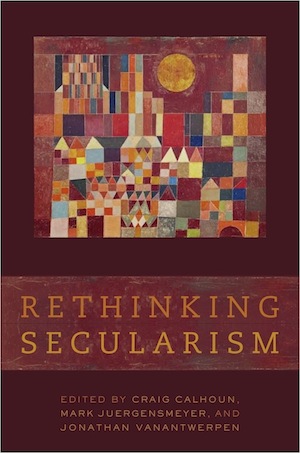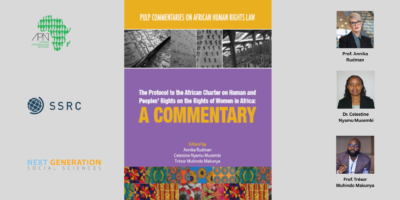Excerpted from “A Suspension of (Dis)Belief: The Secular-Religious Binary and the Study of International Relations, chapter seven of Rethinking Secularism (Oxford University Press, 2011).—ed.
 Most academic discussions in political science and international relations presuppose a fixed definition of the secular and the religious and proceed from there. Most realist, liberal, English school, feminist, and historical-materialist approaches treat religion as either private by prior assumption or a cultural relic to be handled by anthropologists. Even constructivists, known for their attention to historical contingency and social identity, have paid scant attention to the politics of secularism and religion, focusing instead on the interaction of preexisting state units to explain how international norms influence state interests and identity or looking at the social construction of states and the state system with religion left out of the picture.
Most academic discussions in political science and international relations presuppose a fixed definition of the secular and the religious and proceed from there. Most realist, liberal, English school, feminist, and historical-materialist approaches treat religion as either private by prior assumption or a cultural relic to be handled by anthropologists. Even constructivists, known for their attention to historical contingency and social identity, have paid scant attention to the politics of secularism and religion, focusing instead on the interaction of preexisting state units to explain how international norms influence state interests and identity or looking at the social construction of states and the state system with religion left out of the picture.
This disciplinary convention fixes in advance key definitions and terms of inquiry, with some of the most vital aspects of contemporary world politics systematically excluded from consideration. The presumption that religion has been privatized and is no longer operative in modern politics or that its influence can be neatly encapsulated in anthropological studies of a particular religious tradition and its external influence on politics has led scholars of international relations to miss or misconstrue some of the most significant political developments of our time. This narrow vision is in part attributable to a rigid and dehistoricized secular/religious binary that prestructures the field of academic political science and international relations. This academic practice, in turn, mirrors and reinforces particular kinds of limits on political practice, as suggested by the Egyptian example discussed earlier. Expressed and reproduced through both forms of practice, this binary polices the borders of what counts as politics and what counts as religion and how they relate to each other. It has played a critical role in the global production of knowledge. As Alasdair MacIntyre has observed of the fluid relation between theory and practice, “there ought not to be two histories, one of political and moral action and one of political and moral theorizing, because there were not two pasts, one populated only by actions, the other only by theories. Every action is the bearer and expression of more or less theory-laden beliefs and concepts; every piece of theorizing and every expression of belief is a political and moral action.”
To be clear, I do not want to suggest that the categories of the secular and the religious fluctuate so wildly that they lack any analytical, political, or metaphysical salience, depending on one’s perspective, but, rather, that from the perspective of deep pluralism that underlies my argument, these categories cannot be taken for granted in their fixity. Failing to account for the power and limitations of the category of the secular and its shifting and contested relation not only to religion but to other political phenomena cast in opposition to it risks imposing a simplistic and distorted template on world politics. A rigid secular/religious divide stabilizes particular, historically contingent, and often hegemonic definitions of both politics and religion. This makes life easier for social scientists looking for answers in the short run but is costly in a world in which the way these categories come to be defined, what they come to represent and not represent, is critical to understanding how they operate politically.
At the same time, the category of religion is no more obvious than the category of the secular. Reconsidering the fixity of the secular/religious binary opens new epistemological spaces for the identification of forms and locations of politics that fall off the radar screen of conventional secular rationalist approaches to politics and conventional religious approaches to politics. It makes room for alternative instantiations of the secular/religious divide to work their way into political theory and practice, as is occurring today in Turkey and is discussed below.
A second qualification is that not all social scientists are cut from a single mold, and the degree to which any individual, institution, party, state, or international organization unthinkingly reproduces any particular secular/religious binary varies. It would be inaccurate to suggest that everyone approaches these questions in the same way. Yet particular varieties of secularism, like varieties of religion, have had an organizing influence on the ways in which most Europeans and Americans define and relate to basic categorizations involving religion and politics. These categorizations also change over time, as Charles Taylor argues in chapter 1 of this book, with the secular coming to refer in our time to that pertaining to a self-sufficient immanent sphere. The practices, institutions, and ways of being designated as secular sustain and shape the contours of public life and the modern organization of social-scientific knowledge. These traditions do not merely reflect social reality; they help to construct it. They embody attitudes, sensibilities, and habits that facilitate closure and agreement around cultural, political, and legal settlements of the separation of church and state, the definition of religion, and what constitutes normal politics. There is in many contexts an identifiable secular “pattern of political rule,” helping to generate and sustain the category of religion and setting preconditions for particular kinds of academic and political practice.
The unthinking adoption of a rigid secular/religious binary in the social sciences has had at least three consequences for the study of world politics. First, social scientists are encouraged to define research questions, select methods, and present results that fall squarely into the “secular” half of the binary, understood as the domain of rational humanism. They are taught to avoid religion, the domain of the supernatural, superstitious, otherworldly, metaphysical, and so forth. This encourages social scientists to approach religion either not at all or as a particular, emotive (as opposed to secular, rational, and universal) dimension of politics alongside others such as gender, caste, and (at times) nation. The secular/religious binary operates such that not to be secular is to be emotional, irrational, unpredictable, and behind the march of progress. Quietly at work here is the notion that only the West, with its narrative of secularization, has found its way out of the woods, while other civilizations continue to cast about in a desperate search to answer the questions that the West resolved centuries ago. Lodged within this narrative is the assumption that the secular is the natural domain of rational self-interest and universalist ethics. The secular thus comes to stand not only in an oppositional relation to religion but also as the natural counterpart to other dimensions of politics that do not fit comfortably within the categories of either rational self-interest or universalist ethics.
This suggests that the secular is a more powerful and capacious category than one might assume when it is taken to stand only in contradistinction to the religious. Loosening the hold of a fixed secular/religious binary opens up a broader field of inquiry into modern formations of authority than may be apparent at the outset. The secular grounds and secures a place for the good, rational, and universal in Western moral order, which is then opposed to series of nonrational or irrational particularisms, aberrations, or variations. Religion often, though not always, appears as one of these particularisms. It is not the only candidate: institutions and identities associated with (ethnic as opposed to civic) nationalism, race, caste, and gender all have been cast in an oppositional relation to secular rational self-interest and/or universalist ethics. This is the sense in which it is possible to glimpse the capacious power of the category of the secular above and beyond its extraordinary capacity to define and delimit the religious. I return to this below.
A second consequence of the naturalization of the secular/religious binary is that the study of religion and politics tends to focus not on secularism in relation to religion or the other categories discussed above (the binary has effectively segregated these categories) but on predefined religious traditions taken as independent objects of inquiry and the degree to which they infiltrate or influence politics. This division of labor divides inquiry into mainstream (secular) studies on the one hand and studies of religion or religion and politics on the other. A fixed understanding of religion in relation to the secular supports an understanding of the secular as that which is associated with normal, rational politics. Religion becomes a repository for a range of nonrational and nonuniversal dimensions of politics that fall outside the range of “normal” politics, including belief, culture, tradition, mood, and emotion.
A third consequence of the stabilization of the binary is that a particular (often monotheistic) definition of religion is often taken as the norm. This definition constructs an object of study and defines religious actors and institutions according to a particular set of parameters. These limitations press those trained in the traditions of European and American international-relations scholarship to read the world in a particular way, with an emphasis on European religious history and experience, and to misconstrue or miss entirely a whole spectrum of political actors, histories, and processes. Perhaps most significant among these are the intense political struggles, historical contingencies, religious ambivalences, and philosophical uncertainties surrounding the practices associated with and legitimized by claims to the secular itself.
The study of religion, secularism, and international affairs requires a suspension of (dis)belief to address these limitations and move toward new paradigms for the study of global politics. It requires suspending disbelief in the particularity of the secular (or suspending one’s belief in the universalizing potential of the secularization narrative, depending on how you look at it) and approaching the secular/religious binary not as fixed but as shifting, evolving, and elusive. This suspension of (dis)belief can be uncomfortable for those socialized in Euro-American secularisms, which are kept afloat by a high degree of certainty surrounding the stability of these categories. But I hope to show that it is worth the effort. Suspending the assumption that any secular/religious binary is fixed and universal and approaching it as an unstable, historically contingent construct that is capable of sustaining a broad discursive field that goes beyond the maintenance of a distinction between the secular and the religious allows the ground that supports this distinction to shift in intellectually fruitful directions.
And the ground is shifting. Developments in late-modern international relations, such as increasing pluralization within societies, rising global interdependence, the retreat of Christendom, the questioning of the universality of the Enlightenment, and a rise in religiously inspired forms of collective political identification, demand a destabilization of the fundamental terms and binaries (secular rational versus religious irrational, philosophical versus theological, reason versus faith) that have structured inquiry on this subject for decades. Understanding the politics of secularism requires this suspension of (dis)belief. Like their counterparts in philosophy and political theory, international relations theorists need to hone their capacity to pose research questions that do not presuppose fixed definitions of these terms or relations between them. What claims to the secular and the religious signify in different circumstances and what political effects these claims have in various settings are precisely what needs to be explored.











